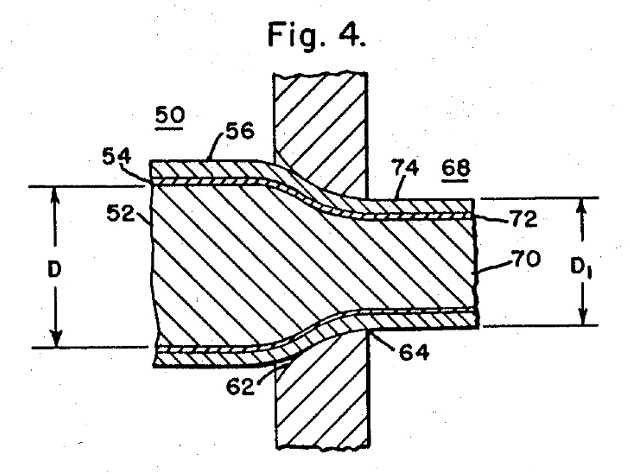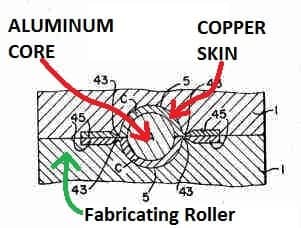Hi infinia,
Good to know. Many thanks.
Have you tried to solder to that wire you think might be aluminum?
-Chris
Good to know. Many thanks.
Have you tried to solder to that wire you think might be aluminum?
-Chris
Hi infinia,
Good to know. Many thanks.
Have you tried to solder to that wire you think might be aluminum?
-Chris
Hi Chris
AFAIK most aluminum wire is copper plated.
the wire above tins well with a drop of liquid flux and solders to anything after that. IDK about corrosion or aging related issues years down the road. it's certainly flexible and heat resistant enough used for refreshing a few older rubber test leads here. I may try to order the 14AWG "pure silicone copper" soon to compare.
I don't know Chris I'm recently learning about this Al wire biz too. kinda sorta looks like copper wire but it isn't. heck if they can plate plastic to look like metal who knows
(why would Pedro's use the acid test above?) my electrical resistance test at 1A is easy and has good confidence /repeatability.
I used to just buy copper wire and be done with it. lol
historically the building trades/ real estate industry has been burned by AL wire before.
maybe the test and hobby trades should remain separate. I guess some would ague if it solders to the connection everything is fine.
(why would Pedro's use the acid test above?) my electrical resistance test at 1A is easy and has good confidence /repeatability.
I used to just buy copper wire and be done with it. lol
historically the building trades/ real estate industry has been burned by AL wire before.
maybe the test and hobby trades should remain separate. I guess some would ague if it solders to the connection everything is fine.
Last edited:
here's a screen grab from a free shipping place E.g. one hobby type place that offers specs of some sort. It's clearly NOT copper and probably undersized as well. The more you dig the fuzzier the picture. AVOID
the current rating must be from the same joke book as the copper statement
stranded wire chart http://www.seas.gwu.edu/~ecelabs/appnotes/PDF/techdat/swc.pdf
the current rating must be from the same joke book as the copper statement
stranded wire chart http://www.seas.gwu.edu/~ecelabs/appnotes/PDF/techdat/swc.pdf
Attachments
Last edited:
here's a screen grab from a free shipping place E.g. one hobby type place that offers specs of some sort. It's clearly NOT copper and probably undersized as well.http://www.seas.gwu.edu/~ecelabs/appnotes/PDF/techdat/swc.pdf
Here is your chance to become an hero by shopping for silver plated cables with MIL specs.
Here is your chance to become an hero by shopping for silver plated cables with MIL specs.
thx I have some, great really for somethings, not all that forgiving for test leads. ( and don't have the proper thermal wire strippers) It's a hoot that the 'hobby world' is pretty sketchy place I have to admit.
my electrical resistance test at 1A is easy and has good confidence /repeatability.
I used the acid test because I am a chemist by trade and wanted to literally see the copper under the tin plating. Saying I measured a certain resistance isn't as definite in a review as actually SHOWING the copper wire underneath the tin plating.
While copper plated aluminum wire does exist and often is passed off as full copper wire by unscrupulous dealers, if the wire is silver in color it is usually just aluminum wire or tinned copper. This is the reason for my test, could I show that there was copper underneath the tin. Solder will stick to aluminum, provided it is 100% free of Al2O3, which is does NOT stick too. In air the Al2O3 forms more or less instantly without aggressive fluxes or special work. I am not sure if much of the aluminum wire is actually tin plated or what but it is most certainly not copper plated first.Hi Chris
AFAIK most aluminum wire is copper plated.
the resistance test is a good one, if it doesn't measure close to copper it's not the real deal.
I also compared bulk resistivity of copper to aluminum alloys used for wire as good confirmation to the measurements. Like I said I'm really surprised by all this pretending of aluminum or plated whatever to be copper. I don't claim to be an expert in aluminum wire passing as copper game. If you can shed some light to the practice we'd be interested.
BTW Id stand by my testing proving what it aint and probably what's its closer to, being better than showing copper color after etching the tin away> not discrediting your efforts at all Pedro! haha we pick our own tools to beat the bad guys.
I also compared bulk resistivity of copper to aluminum alloys used for wire as good confirmation to the measurements. Like I said I'm really surprised by all this pretending of aluminum or plated whatever to be copper. I don't claim to be an expert in aluminum wire passing as copper game. If you can shed some light to the practice we'd be interested.
BTW Id stand by my testing proving what it aint and probably what's its closer to, being better than showing copper color after etching the tin away> not discrediting your efforts at all Pedro! haha we pick our own tools to beat the bad guys.
Last edited:
Hi infinia,
It seems to me that all Al connections I had seen are crimped/clamped. Not soldered. So they certainly could be used in test lead sets. I would think that Al would be too brittle to last in that application.
-Chris
Yup, and here in Canada, the electrical safety guys approved it for residential use. It was less expensive than copper at the time, not sure about today's market. I lived in a townhouse built in the 70's which had Al wiring. I spent the entire time smelling smoke and having electrical "issues". We finally broke the lease and I have slept soundly ever since in a home built in 2000. No worries of an electrical fire, and no more funny electrical issues.historically the building trades/ real estate industry has been burned by AL wire before.
It seems to me that all Al connections I had seen are crimped/clamped. Not soldered. So they certainly could be used in test lead sets. I would think that Al would be too brittle to last in that application.
-Chris
It seems to me that all Al connections I had seen are crimped/clamped. Not soldered. So they certainly could be used in test lead sets. I would think that
-Chris
indeed you cant just simply replace Al for copper, there is a whole nest of issues. Al should be used when it makes sense, but please why do they need to shove it down our throats and lie about it. Is this hobby wire thing just the tip of an iceberg? what about battery jumper cables, speaker wire , Christmas lights, ...?
Al would be too brittle to last in that application.
Bingo
Last edited:
the resistance test is a good one, if it doesn't measure close to copper it's not the real deal.
I also compared bulk resistivity of copper to aluminum alloys used for wire as good confirmation to the measurements. Like I said I'm really surprised by all this pretending of aluminum or plated whatever to be copper. I don't claim to be an expert in aluminum wire passing as copper game. If you can shed some light to the practice we'd be interested.
BTW Id stand by my testing proving what it aint and probably what's its closer to, being better than showing copper color after etching the tin away> not discrediting your efforts at all Pedro! haha we pick our own tools to beat the bad guys.
One thing that your method does not take into account is that tin plating copper actually raises the resistance of the copper. I have YET to find an article with exact values but have found several references that tin plating causes intermetallic formations via alloying of the tin into the copper and it results in a net increase in the resistance of the wire. One paper I said comparing the various methods said it raises it signficantly, but frustratingly none quantify these vague terms. I significant for them 2000%, 200%, 20%, 2% or 0.2%; I have been in situations where I have used significantly to describe any of these orders of magnitude. Clearly, the higher the strand count the wire (assuming the same size) the more this plating will play a role due to the increased fractional surface area being alloyed. But all of this is handwaving until I can get some legitimate values. I agree there are limitations to my method. I actually plan on undertaking a much more chemically rigorous method to qualitatively identify copper itself in the future. Just haven't had time to research it better.
indeed you cant just simply replace Al for copper, there is a whole nest of issues. Al should be used when it makes sense, but please why do they need to shove it down our throats and lie about it. Is this hobby wire thing just the tip of an iceberg? what about battery jumper cables, speaker wire , Christmas lights, ...?
Aluminum (and more deviously copper plated aluminum) wire is already often used in battery jumper cables, welding leads and high wattage amp leads. The rule of thumb is to go 2 AWG bigger when going from Al to Cu. So if you need a 10AWG wire for Cu then you need 8AWG Al. Aluminum in and of itself doesn't have too many issues other than increased size. Though one glaring issue is that it should NOT be used in direct contact with copper due to galvanic corrosion which can result in structural failure of the wire or worse. Also, certainly you should get what you pay for and what is described, that is unacceptable to me.
Last edited:
I don't know Chris I'm recently learning about this Al wire biz too. kinda sorta looks like copper wire but it isn't. heck if they can plate plastic to look like metal who knows
(why would Pedro's use the acid test above?) my electrical resistance test at 1A is easy and has good confidence /repeatability.
I used to just buy copper wire and be done with it. lol
historically the building trades/ real estate industry has been burned by AL wire before.
maybe the test and hobby trades should remain separate. I guess some would ague if it solders to the connection everything is fine.
I decided to make you happy and do an electrical test! I just tested the resistance of the wire from my seller, using a tester currently under review. My 1 meter 14AWG wire (including banana plugs) has a resistance of 8.689mOhms. This is VERY close to the solid copper 14AWG resistance of 8.450mOhms.

EDIT: I guess that answers the question on how much tin plating affects the resistance. Basically not at all at DC-Low Frequencies.
I measured my other cables made from the same 14AWG wire:
8.720, 8.662, 8.722, 8.688, and 8.682mOhm/meter. This gives an average of 8.694mOhm/meter. If you factor in that these include the soldered on banana plug, as mentioned before, this is VERY close to the value for solid copper.
I think with 100% certainty, I can say that Franky's wire is copper and also his banana plugs are very solid quality as well.
Last edited:
I think with 100% certainty, I can say that Franky's wire is copper and also his banana plugs are very solid quality as well.
nope only for your item, which is a custom kit.
looking at his 'hobby store' most of the standard product looks regular junky China = no specs or source QA controls. Even if you tested every line item, whos to say he can't change it over time?
egads I wonder about your incentives to promote here somewhat shamelessly.
I think you where right before! Tin plating is perhaps another filler material for super fine stranded product. its a worse conductor than Al.
Last edited:
nope only for your item, which is a custom kit.
looking at his 'hobby store' most of the standard product looks regular junky China = no specs or source QA controls.
egads I wonder about your incentives to promote here somewhat shamelessly.
I think you where right before! Tin plating is perhaps another filler material for super fine stranded product. its a worse conductor than Al.
Whatever. I thought you would be happy with me providing the electrical results. I am just reporting what I have, nothing less nothing more. You mentioned electrical resistance as being more reliable than my chemical test. I have a device under review that was capable of measuring the resistance so I did. As far as I know, this is just his typical copper wire considering he makes the kit from parts that he sells. To be honest, this is a big reason on why I was loathe to provide his name because people would think I was shilling for him. I do NOT ever, nor will ever, lie or mislead to shill for someone. I haven't done it for Tronex, nor Der EE, nor anyone else. I get nothing out of this and only report the truth. I have found everythign he sells to have been very solid quality. I am not quite sure what you are wanting anymore. Possibly more than ANY manufacturer provides.
As for if he can change it or not, he sure can that is where the trust comes in. I, and many others over at EEVBlog, have been dealing with him for years and he has shown himself to be very honest. That means something to me, but at the end of the day, everyone can trust or not based on their experience. Trust is earned, not given.
Last edited:
I don't mind buying if they are open to inquiries, if he presents specs or says what he is selling, but my trust is diminishing rapidly from what I'm finding, just from talking to you here and my own limited experiences with other sources of raw components. maybe its not what you say but how. (can you really make such a global sweeping statement by looking at one bit of kit?? ) I doubt all his standard product is under his full control. whatever
Sure i'd trust him more than most, but look at his competition, sadly it's not exactly a level playing field he's operating from.
Sure i'd trust him more than most, but look at his competition, sadly it's not exactly a level playing field he's operating from.
Last edited:
Hi infinia,
Interesting. I didn't know that aluminum could be plated with copper.
-Chris
The common methods for applying the copper coating are mechanical, not chemical:
http://http://inspectapedia.com/aluminum/Copper_Clad_Aluminum_Wire.php
Copper coating applied as part of the wire drawing process:

Copper coating applied by rolling:

If uncoated copper is being compared to tinned copper, or to Tin plated copper, for changes in resistance, then maybe one should be looking at what effect copper corrosion will have on the resistance after a few hours/years of operation.
I have a sneaky feeling that copper oxide has a higher resistance than the tin affected zone at the surface of the tin plated copper.
I have a sneaky feeling that copper oxide has a higher resistance than the tin affected zone at the surface of the tin plated copper.
EDIT: I guess that answers the question on how much tin plating affects the resistance. Basically not at all at DC-Low Frequencies.
Well, that's what you would expect, since the plating and the interface are pretty small compared to the cross sectional area. Diffusion through a crystalline solid is relatively slow (even slower when cooled!) and the plating process is relatively fast. RF measurements might show a significant difference.
To your question about "significant," the conductivity difference between copper and tin is about a factor of 10, so that would presumably set a bound on resistance change.
Hi Arny,
Thank you. That explains that particular mystery for me.
Now, the extra complications from drawing the aluminum wire along with a copper skin would make this wire much more expensive, wouldn't it? There must be a point where it simply isn't worthwhile to make wire in this way.
Hi SY,
If skin effect forces the RF energy into the copper, wouldn't the resistance drop with increasing frequency? I'm thinking that if the copper is drawn along with the Al core, it would be thicker than plating would be. Therefore there might be a significant drop in resistance as the frequency goes up - ignoring inductance.
-Chris
Thank you. That explains that particular mystery for me.
Now, the extra complications from drawing the aluminum wire along with a copper skin would make this wire much more expensive, wouldn't it? There must be a point where it simply isn't worthwhile to make wire in this way.
Hi SY,
If skin effect forces the RF energy into the copper, wouldn't the resistance drop with increasing frequency? I'm thinking that if the copper is drawn along with the Al core, it would be thicker than plating would be. Therefore there might be a significant drop in resistance as the frequency goes up - ignoring inductance.
-Chris
- Status
- Not open for further replies.
- Home
- Design & Build
- Equipment & Tools
- DIY Kelvin Test Lead Kit

